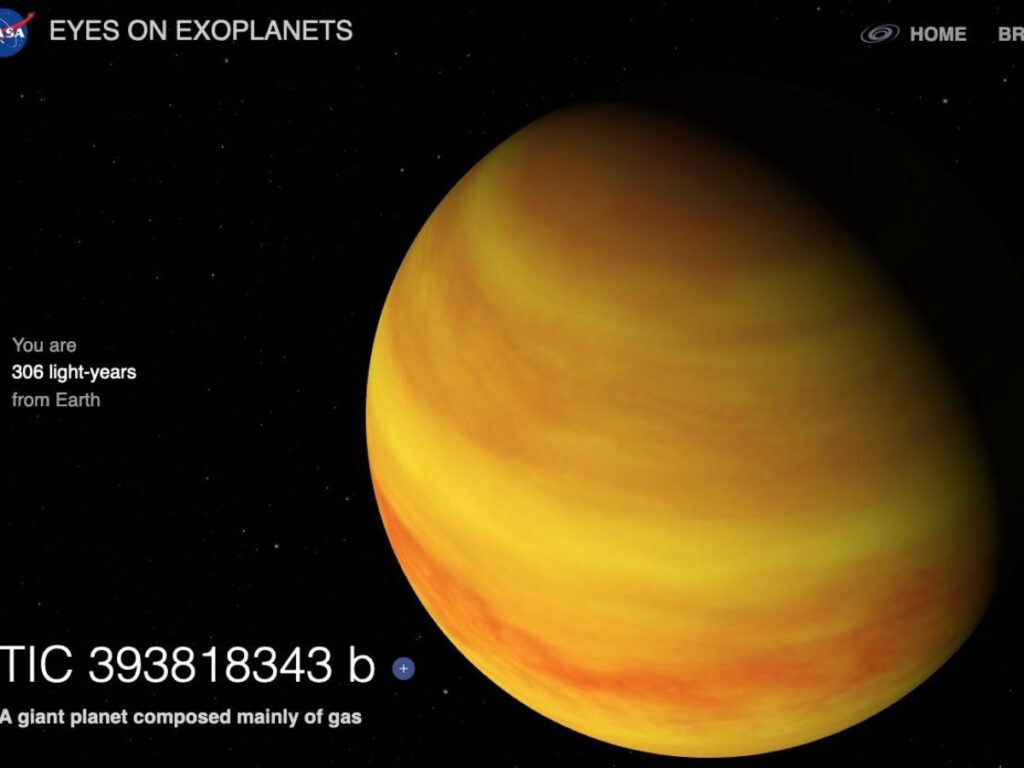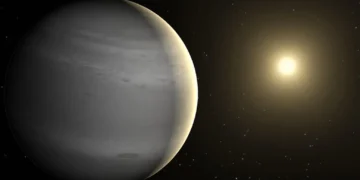In an extraordinary collaboration, NASA-backed amateur astronomers have confirmed the discovery of a massive exoplanet, TIC 393818343 b. This new candidate exoplanet, proposed in ExoFOP by G. Conzo and M. Moriconi, was promoted from TIC 393818343 to TOI-6883.01 at coordinates R.A.(J2000)20:41:10.01 decl.(J2000) + 3:38:17.87 in the Delphinus constellation and its distance is (93.73 ± 0.35) pc from Earth.
This breakthrough proves that with a backyard telescope, citizen scientists can make real contributions to astronomy, no longer leaving the exploration of distant worlds to just the professionals.
The Discovery of TIC 393818343 b: A Collaborative Effort
The story of TIC 393818343 b begins with NASA’s Transiting Exoplanet Survey Satellite (TESS), a mission dedicated to finding planets beyond our solar system. TESS detects exoplanets by using a method called the transit technique. Essentially, the satellite observes stars and looks for periodic dimming caused by a planet passing in front of its host star. While TESS can identify thousands of potential exoplanets, confirming their existence requires detailed follow-up observations—this is where the collaboration between professional and amateur astronomers shines.
The UNITE and Exoplanet Watch teams joined forces after TESS detected a possible transit of TIC 393818343 b. Citizen scientists, armed with telescopes and passion, were called upon to help confirm this discovery by observing the planet’s next transit. These teams succeeded in observing two additional transits, confirming that the object detected by TESS was indeed a planet.

credits:NASA.
What Makes TIC 393818343 b Special?
TIC 393818343 b is classified as a “warm Jupiter,” a gas giant similar in size to Jupiter but orbiting much closer to its star. Its orbit is a mere 12% of the distance between Earth and the Sun, resulting in a “year” on TIC 393818343 b that lasts only 16 Earth days.
What makes this exoplanet particularly intriguing is its highly eccentric orbit, with an eccentricity of 0.6, meaning it follows an elongated path around its star. This extreme orbit differentiates it from the more circular paths of planets like those in our solar system, including Jupiter, which has a relatively low eccentricity.
Warm Jupiters like TIC 393818343 b are especially interesting because they represent a transitional stage between “regular” gas giants, like Jupiter in our solar system, and “hot Jupiters.” Hot Jupiters orbit so close to their stars that their atmospheres are puffed up by the intense heat.
These planets are thought to be in the final stages of a migratory process, moving closer to their stars over time. For astronomers, TIC 393818343 b provides a rare opportunity to study this migratory phase in real-time.
The Role of Citizen Science in Exoplanet Discovery
The confirmation of TIC 393818343 b is a testament to the growing role of citizen science in modern astronomy. Citizen scientists, like those involved in the UNITE and Exoplanet Watch projects, contribute valuable data that would otherwise require countless hours of telescope time from professional astronomers.
In this case, amateur astronomers across the globe worked together to observe the planet’s predicted transit, helping to gather the evidence needed to confirm its existence.
This approach democratizes astronomy, allowing enthusiasts from all walks of life to participate in groundbreaking research. By leveraging global networks of amateur astronomers equipped with relatively inexpensive equipment, projects like UNITE and Exoplanet Watch significantly expand the capacity for data collection and validation. For many of these citizen scientists, like Australian volunteer Darren Rivett, this work is more than just a hobby—it’s a meaningful contribution to the field of astronomy.
Why This Discovery Matters
The discovery of TIC 393818343 b is more than just another exoplanet added to the growing list—it’s a key to unlocking some of the most fundamental questions about how planetary systems form and evolve. Warm Jupiters are believed to be an intermediate stage in the journey of gas giants as they migrate inward toward their stars.
In the case of TIC 393818343 b, its highly eccentric orbit could offer clues about the forces driving this migration. Are these planets being nudged inward by interactions with other planets, or are they being pulled along by the remnants of the protoplanetary disk from which they formed? By studying planets like TIC 393818343 b, astronomers can begin to piece together the puzzle of how planetary systems, including our own, develop and change over time.
Moreover, the discovery highlights the potential for more discoveries in the future. With thousands of candidate exoplanets identified by TESS, there is no shortage of work to be done. The involvement of citizen scientists means that professional astronomers can focus their resources on the most promising targets, while still ensuring that as many exoplanet candidates as possible are either confirmed or ruled out.
The Future of Exoplanet Research
TIC 393818343 b is just the beginning. As technology advances and more people become involved in citizen science, the potential for discoveries will only grow. The UNITE and Exoplanet Watch projects exemplify how collaborative efforts can accelerate the pace of discovery and deepen our understanding of the universe.
These projects are part of a broader trend in science that values the contributions of citizen scientists, opening up opportunities for individuals to be part of cutting-edge research.
In the future, we may see more exoplanets like TIC 393818343 b discovered and studied, leading to breakthroughs in our understanding of planetary systems. Perhaps even more exciting is the possibility of finding planets in the habitable zone of their stars, where conditions might be right for life.
The discovery of TIC 393818343 b is a significant milestone in the ongoing search for exoplanets, not only because of what it tells us about planetary migration but also because of how it was discovered. The success of the UNITE and Exoplanet Watch projects demonstrates the power of citizen science in contributing to real scientific advancements.
As more exoplanets are discovered and our understanding of planetary systems deepens, it’s clear that the future of astronomy will be a collaborative effort, bringing together professionals and amateurs alike. TIC 393818343 b may just be the first step in a much larger journey, one that will continue to reveal the wonders of the universe and the fascinating worlds that exist beyond our own.
Reference:
Smith, J. R., Rivett, D., Saibi, S., & UNITE Team. (2024). Confirmation and Characterization of the Eccentric, Warm Jupiter TIC 393818343 b with a Network of Citizen Scientists. The Astronomical Journal.
“Possible Detection of a Fast Radio Burst Counterpart of a Gravitational Wave Event.” Research Notes of the AAS, 8(53). Retrieved from http://ui.adsabs.harvard.edu/abs/2024RNAAS…8…53C/abstrhttps://ui.adsabs.harvard.edu/abs/2024RNAAS…8…53C/abstract



















